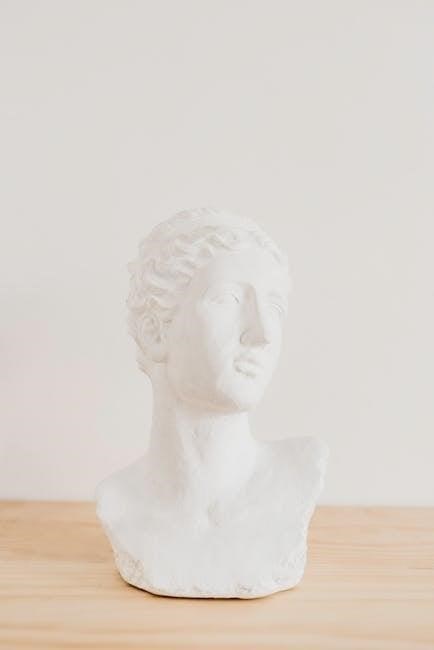John Keats’ Ode on a Grecian Urn is a masterful exploration of art, time, and human experience. Written in 1819, this ekphrastic poem engages with a Greek urn’s imagery, delving into themes of beauty, truth, and the transcendence of art beyond mortal life. Its intricate dialogue with the urn unfolds as a meditation on the timeless and the fleeting, offering profound insights into the essence of existence.
Overview of the Poem
Ode on a Grecian Urn is a poetic masterpiece by John Keats, written in May 1819. The poem is an ekphrastic work, meaning it describes and engages with a visual artwork—in this case, a Greek urn adorned with scenes of youth, love, and sacrifice. Keats explores the timeless beauty of art, contrasting it with the transient nature of human life. The urn, as a silent yet expressive object, becomes a vessel for profound reflections on truth, beauty, and the human condition. Through its intricate language and structure, the poem invites readers to contemplate the enduring power of art to transcend mortality and speak across centuries.
Historical Context of the Poem
Ode on a Grecian Urn was composed during the Romantic era, a period of artistic and literary flourishing in early 19th-century England. John Keats, deeply influenced by classical Greek art and philosophy, wrote the poem amidst personal turmoil, including the loss of his brother and his own struggles with illness. The poem reflects the Romantic fascination with the past and the idealization of ancient Greece as a symbol of timeless beauty and truth. Keats’ contemporaries were also drawn to classical antiquities, which were becoming more accessible through archaeological discoveries. This cultural and historical backdrop shaped the poem’s themes of art’s immortality and the transience of life, resonating with the intellectual and emotional currents of Keats’ time.
Structure and Form of the Poem
The poem employs a structured, lyrical form with a consistent rhyme scheme and meter. Its use of ekphrasis creates vivid imagery, enhancing its timeless beauty and depth.
The Use of Ekphrasis in the Poem
Ekphrasis, a Greek word meaning “to describe a work of art,” is central to Keats’ poem. The urn’s scenes are vividly depicted, transforming visual art into words. This technique allows Keats to explore themes like beauty, truth, and immortality. By engaging with the urn, Keats creates a dialogue between the poet and the artwork, blending the static nature of the urn with dynamic poetic imagination. The poem’s ekphrastic style invites readers to visualize the urn’s imagery, emphasizing art’s power to transcend time and reality. This approach not only highlights the urn’s beauty but also reflects Keats’ belief that art can capture moments of eternal truth and emotion.

Rhyme Scheme and Meter
Keats’ Ode on a Grecian Urn follows a structured rhyme scheme of ABAB CDE CDE, typical of odes, which adds to its musicality and formal beauty. The poem is primarily written in iambic pentameter, with each line consisting of five beats, creating a rhythmic flow that enhances the contemplative tone. The consistent meter and rhyme scheme provide a sense of order, mirroring the timeless and unchanging nature of the urn itself. However, Keats occasionally varies the meter to emphasize emotional intensity or philosophical depth, showcasing his mastery of poetic form. This blend of structure and subtle variation underscores the poem’s exploration of art’s enduring power and universal truths.

Themes Explored in the Poem
John Keats’ Ode on a Grecian Urn explores themes of beauty, truth, and the immortality of art, contrasting with life’s transient nature and human longing for eternal connection.
The Beauty and Truth of Art
John Keats’ Ode on a Grecian Urn profoundly explores the interplay between beauty and truth, positing that art transcends time and reality. The urn, as a static yet vibrant work of art, embodies eternal beauty, capturing moments frozen in time. Keats argues that truth is found in the aesthetic and emotional resonance of art, which speaks to universal human experiences. The poem suggests that while life is fleeting, art endures, offering a glimpse of the divine. Through the urn’s imagery, Keats conveys the idea that beauty is not merely superficial but a reflection of profound truths about existence. This theme is central to the poem’s celebration of art’s immortality and its ability to evoke deep emotional and philosophical contemplation in the viewer.
The Immortality of Art vs. the Transience of Life
John Keats’ Ode on a Grecian Urn vividly contrasts the enduring nature of art with the fleeting essence of human life. The urn, as an ancient artifact, symbolizes the timelessness of art, while the scenes it depicts—of love, joy, and sacrifice—underscore the transience of mortal experiences. Keats highlights how art, unlike life, remains static yet eternally vivid, preserving moments that would otherwise fade. The poem suggests that while human existence is brief and fragile, art transcends time, offering a window into the past and a testament to the enduring human spirit. This duality is central to the poem’s meditation on the paradox of existence, where art serves as a lasting reflection of life’s impermanence.
Love and Longing in the Poem
In Ode on a Grecian Urn, Keats explores love and longing through the frozen scenes depicted on the urn. The immortal lovers, forever poised on the brink of embrace, symbolize the bittersweet nature of desire. Their permanent separation highlights the transient fulfillment of human passion, contrasting with the eternal promise of art. The piper’s melody, equally frozen in time, evokes a sense of yearning for something unattainable. Keats’ portrayal of these static yet emotionally charged scenes underscores the enduring power of love and its inherent melancholy. The urn’s imagery serves as a poignant reminder of the interplay between beauty, loss, and the human experience, transcending time to resonate with universal emotions. This theme is central to the poem’s exploration of the human condition.

Analysis of Key Stanzas
The poem’s five stanzas offer a profound exploration of the urn’s imagery, each advancing themes of beauty, truth, and the timeless essence of art over human transience.
First Stanza: Addressing the Urn
The first stanza of Ode on a Grecian Urn introduces the urn as a silent, timeless vessel of beauty and truth. Keats personifies the urn, addressing it as a “still unravish’d bride of quietness” and a “foster-child of silence and slow time,” emphasizing its enduring and unchanging nature. Through vivid imagery, the poet establishes the urn as a narrator of ancient stories, frozen in time. The stanza sets the tone for the poem’s exploration of art’s ability to transcend mortality, inviting the reader to contemplate the deeper truths embedded in the urn’s depictions. This opening stanza seamlessly blends reverence for the urn’s beauty with a philosophical inquiry into the essence of art and existence.

Second Stanza: The Depiction of Scenes on the Urn
The second stanza vividly describes the scenes etched into the urn, depicting a procession leading to a sacrifice and figures carved in marble. Keats’ imagery brings to life the pensive maidens, musicians, and priests, creating a dynamic yet frozen moment. The stanza highlights the contrast between the static art and the living emotions it evokes. By engaging with these visuals, Keats explores the interplay of movement and stillness, inviting the reader to reflect on the enduring power of art to capture human experience. This stanza establishes the urn as a window into an eternal, idyllic world, where beauty and emotion transcend time.
Third Stanza: The Frozen Moment in Time
The third stanza captures the essence of a moment frozen in time, where the figures on the urn remain perpetually suspended. Keats describes the piper, whose music is unheard yet eternal, and the lovers who never consummate their passion. This stanza underscores the paradox of art preserving life’s intensity while halting its progression. The urn’s static scenes, paradoxically, convey the dynamism of human emotion, allowing the viewer to reflect on the transience of life. Keats’ imagery emphasizes the timeless beauty of art, which transcends mortal limitations, offering a profound meditation on the human condition and the enduring power of artistic expression.
Fourth Stanza: The Bittersweet Nature of Beauty
The fourth stanza delves into the bittersweet nature of beauty, where joy and sorrow coexist. Keats portrays the piper forever piping songs that no one hears and the lover who never reaches his beloved, emphasizing the unfulfilled yet eternal nature of desire. The urn’s depiction of these scenes highlights the paradox of beauty: it is both timeless and transitory, offering moments of perfection that can never truly be grasped. This stanza evokes a sense of melancholy, as the viewer is reminded of life’s fleeting nature and the unattainable ideals captured in art. Keats’ words invite a philosophical reflection on the human condition, where beauty and longing intertwine, leaving a profound emotional resonance. The stanza thus deepens the poem’s exploration of art’s power to capture and transcend mortal experience.
Fifth Stanza: The Conclusion and Final Message
The fifth stanza serves as the poem’s culmination, delivering its final, enduring message. Keats famously declares, “Beauty is truth, truth beauty,” encapsulating the essence of art’s timeless wisdom. The stanza emphasizes the urn’s silence and its profound communication of beauty and truth, transcending mortal limitations. The concluding lines underscore the immortality of art, contrasting it with life’s transience. Keats’ message resonates universally, affirming art’s power to capture and convey eternal truths. This stanza leaves readers with a philosophical reflection on beauty, truth, and the enduring legacy of art, solidifying the poem’s central themes in a poignant and memorable way.
Legacy and Impact of the Poem
Ode on a Grecian Urn remains a cornerstone of Romantic literature, influencing countless artists and writers. Its timeless themes continue to resonate, ensuring its enduring relevance in modern times.
Influence on Later Artists and Writers
John Keats’ Ode on a Grecian Urn has profoundly influenced later artists and writers, shaping Romantic and subsequent literary movements. Its exploration of beauty, truth, and time inspired poets like T.S. Eliot and W.B. Yeats, who drew on its themes of transcendence. The poem’s ekphrastic style has also impacted visual artists, with the Pre-Raphaelites and Symbolists finding inspiration in its vivid imagery. Its philosophical depth has resonated in modern literature, encouraging writers to explore the interplay of art and life. The poem’s legacy extends beyond literature, influencing painters, musicians, and thinkers. Its timeless message continues to inspire, cementing its place as a cornerstone of artistic expression. Keats’ masterpiece remains a source of creative and intellectual stimulation, bridging centuries and disciplines with its enduring relevance.
Modern Interpretations and Relevance
Modern readers continue to find profound relevance in Keats’ Ode on a Grecian Urn, as its themes of beauty, truth, and the immortality of art resonate across time. The poem’s exploration of art as a window to eternal truths parallels contemporary discussions on the role of art in society. Digital media has further amplified its reach, with the urn’s static imagery contrasting yet complementing dynamic modern forms of artistic expression. The poem’s message about the transformative power of beauty and the fleeting nature of life encourages mindfulness and reflection, appealing to a global audience. Its universal themes ensure its enduring relevance, making it a timeless bridge between past and present, inviting readers to ponder the essence of art and existence in their own lives.
